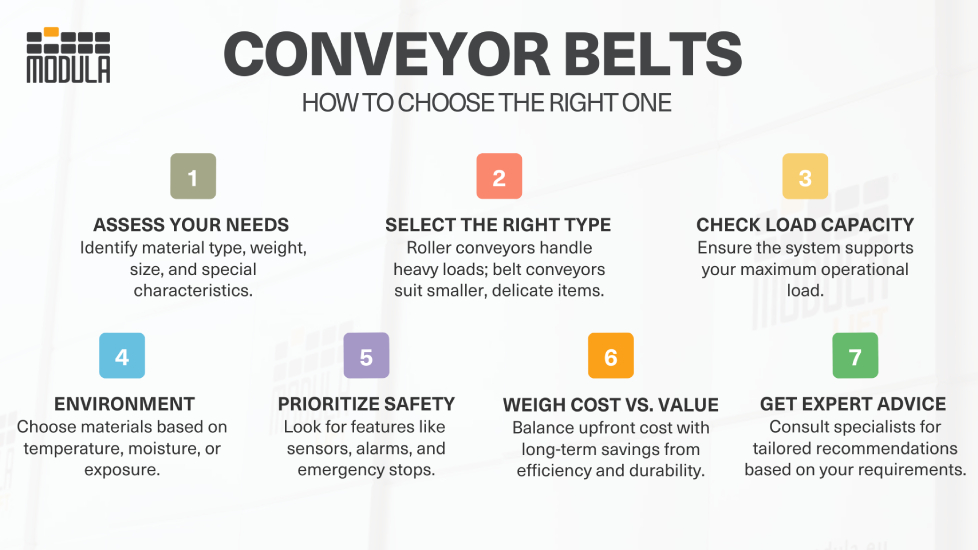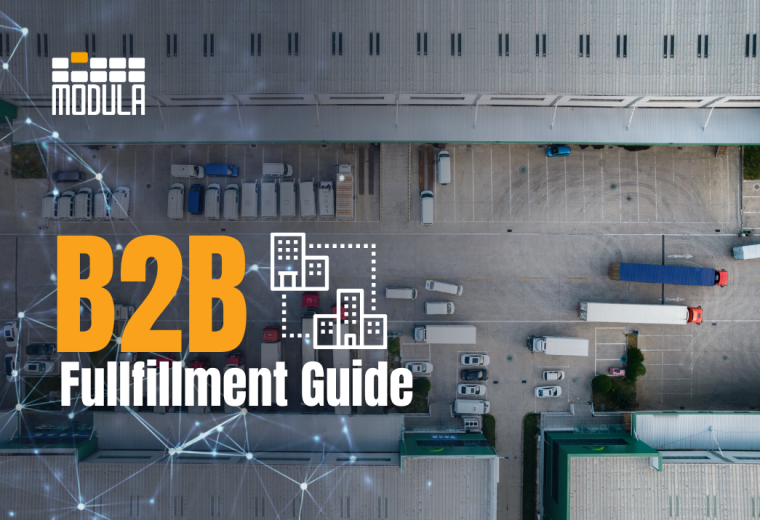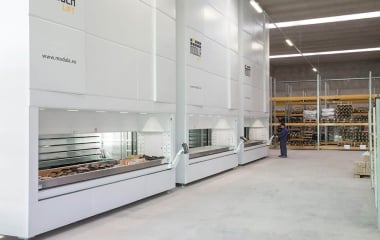A 101 Guide to Warehouse Conveyors [Types, Uses + FAQs]
Conveyor belts are essential tools that streamline the transportation of goods within a facility, ensuring that items move seamlessly through different warehouse areas.
Built to accommodate everything from small packages to bulky pallets, these automated systems provide a versatile solution for diverse operational demands.
In this article, we will:
- Discuss the different types of warehouse conveyor belts
- Share the types of materials used in warehouse conveyor belts
- Explain how to improve material handling with Modula’s automated storage and retrieval systems (ASRS)
8 Unique Warehouse Conveyor Belt Types
Warehouse conveyor belts come in various types. Each conveyor type offers unique features and benefits, tailored to accommodate specific items and operational demands.
Roller Conveyor Belts
Roller conveyor belts feature a series of rollers beneath the belt to facilitate smooth, low-friction movement of goods.
They can be motor-driven or gravity-based, allowing inventory to move downhill effortlessly.
Roller conveyors are ideal for transporting boxes, pallets and other items with firm bottoms and are commonly used in shipping and receiving areas and assembly lines.
Belt Conveyors
These conveyors consist of a continuous belt made from materials such as rubber, PVC or fabric, moving over a series of pulleys.
Motors power these conveyors, enabling the transport of various sizes and shapes of items.
Belt conveyors are versatile and suitable for moving products along flat or inclined paths. They are commonly used in packaging lines and sorting operations.
Modular Conveyor Belts
Constructed from interlocking plastic modules in a brick-laid pattern, these belts offer high durability and flexibility. They can be easily cleaned and reconfigured to accommodate various layouts.
These conveyors are used in food processing, pharmaceuticals and other applications requiring high hygiene levels or frequent changes in the conveyor path.
Flexible Conveyor Belts
Flexible conveyors are extendable, featuring sections that can be curved, stretched and contracted. Typically, they consist of steel rollers or skate wheels mounted on a flexible frame.
They are best suited for loading and unloading trucks, maneuvering goods around obstacles, and setting up temporary configurations in shipping areas.
Slat Conveyor Belts
Slat conveyors feature slats or plates attached to a chain, providing a solid, flat surface for products as they move along the conveyor.
These conveyors are ideal for transporting heavy or hot items, such as metal parts, which might damage other types of conveyors.
Slat conveyor belts are also useful in assembly lines and for moving items through ovens or cooling areas.
Spiral Conveyor Belts
Spiral conveyors optimize space by transporting items vertically. They consist of a continuous belt that forms a spiral path, enabling items to ascend or descend within a compact area.
These conveyors are ideal for multi-level warehousing operations where space is limited, efficiently connecting different floors or levels.
Pallet Conveyor Belts
Specifically designed to transport pallets, these conveyors handle heavy loads and are available in roller or chain versions.
Pallet conveyors are essential in warehouses that deal with bulk goods and heavy items, facilitating the movement of pallets to and from storage areas and loading docks.
Specialty Conveyor Belts
Specialty conveyor belts are designed for specific applications, including heat-resistant belts for high-temperature environments and oil-resistant belts for industries handling oily or greasy products.
Types of Materials Used in Warehouse Conveyor Belts
Conveyor belts are made from a wide range of materials, each suited for various industrial applications.
- Rubber belts: Rubber conveyor belts can efficiently transport heavy loads. However, they can become brittle and crack in cold conditions or soften and deform in high heat.
- PVC belts: PVC belts are resistant to chemicals, oils and greases, making them suitable for handling food products. However, they might not handle heavy loads as effectively as rubber belts.
- Fabric belts: Lightweight and flexible, fabric belts are perfect for food processing or packaging applications but lack the strength and durability required for heavy-duty tasks.
- Steel or metal belts: Stainless steel conveyor belts come in various types, including mesh, chain rod, balanced weave and flat wire. They excel in high-temperature environments and offer unmatched durability.
- Modular plastic belts: Known for their flexibility and easy maintenance, especially in warehouses that handle pharmaceutical products, have lower load capacities compared to metal conveyor belts.
- Wire mesh belts: Wire mesh belts, which provide optimal airflow and durability, are ideal for drying processes and cold chain logistics that require consistent air circulation for temperature control. However, their open design doesn’t suit handling small parts that could slip through the gaps.

How To Match the Appropriate Conveyor Belt for Your Operational Needs
Each sector presents its own set of challenges and requirements, from the sensitive handling needed in pharmaceutical companies to the demands of heavy manufacturing.
This is why choosing the appropriate warehouse conveyor type with your specific industry needs in mind is important.
Manufacturing and Assembly Lines
Roller conveyor belts can seamlessly transport inventory in the manufacturing industry, as they can handle heavy loads and facilitate easy movement along the production line.
Food Processing and Pharmaceuticals
Modular plastic conveyor belts are ideal for the food and beverage industry and pharmaceutical sector due to their easy maintenance and versatile configurations, which are crucial for upholding strict sanitation standards.
ECommerce and Retail Distribution Centers
From small consumer goods to large electronics, belt conveyors versatile and ensure precise handling, making them essential in the packaging and distribution sectors where they can seamlessly transport different types of packaged goods.
Heavy Industry and Metalworking
Slat conveyor belts are ideal for transporting heavy or hot materials, such as steel billets and scrap metals.
Multi-level Warehousing and Logistics
Spiral conveyor belts offer a compact solution for vertical transportation, efficiently connecting various floors or levels without requiring a large footprint of floor space.
Bulk Material Handling
Pallet conveyor systems are specifically designed for the heavy-duty transportation of pallets, large containers or totes.
This makes them crucial for industries that focus on bulk material handling and storage.
How To Choose the Right Warehouse Conveyor Belt for Your Operations
Selecting the right warehouse conveyor belt for your operations involves several key considerations to ensure efficiency, safety and cost-effectiveness.
Assess Your Material Handling Needs
Identify the types of materials your conveyor will transport. Consider the weight, size and characteristics of your inventory (for example, whether they are abrasive or corrosive).
Consider the Conveyor Type
Modular plastic conveyor belts are ideal for the food and beverage industry and pharmaceutical sector due to their easy maintenance and versatile configurations, which are crucial for upholding strict sanitation standards.
Evaluate the Load Capacity
Ensure the conveyor belt can handle your operations’ maximum load. This includes both the weight capacity per foot and the total load capacity.
Analyze the Operational Environment
Factors such as temperature, moisture and exposure to chemicals or other harsh conditions can affect the performance and durability of a conveyor belt.
Choose a material and design that can withstand your specific environment.
Consider Safety Features
Ensure the conveyor system complies with industry safety standards and includes features like sensors, alarms, emergency stops and barriers to prevent potential injuries.
Calculate Cost-Effectiveness
While the initial purchase price is a significant factor, also assess the ongoing operational and maintenance expenses throughout the conveyor system’s lifespan.
Opt for a system that offers a balance between upfront costs and long-term benefits.
For example, a conveyor system with a higher initial cost that features energy-efficient motors can reduce electricity bills over time.
This investment can generate significant cost savings compared to a lower-cost system that demands frequent maintenance and consumes more energy.
Consult the Experts
Talk to conveyor system experts or manufacturers who can provide insights and recommendations based on your specific requirements.
They can evaluate factors such as load capacity, material type, environmental conditions and workload efficiency to help you get the most suitable conveyor belt system.

Optimize Material Handling with Modula’s Automated Storage and Retrieval Systems (ASRS)
Enhance efficiency and streamline operations with Modula’s automated storage and retrieval systems (ASRS) — a cutting-edge solution that seamlessly integrates with conveyor systems to improve material handling.
Modula’s ASRS decrease — or even eliminate — manual labor while improving picking accuracy and operational speed.
By working in conjunction with conveyor systems, it ensures a smooth, continuous flow of materials to maximize space and accelerate order fulfillment.
Key benefits of Modula ASRS include:
Seamless conveyor integration: Automates product movement between storage and processing areas.
- Better space efficiency: Uses vertical storage to free up valuable floor space.
- Increased accuracy and speed: Reduces errors and accelerates picking and retrieval.
- Enhanced safety and ergonomics: Minimizes worker strain by automating repetitive tasks.
- Real-time inventory control: Provides instant access to inventory data for better supply chain management.
Warehouse Conveyor: FAQs
What are warehouse conveyor belts?
Warehouse conveyor belts are automated systems that efficiently transport materials and goods within a facility.
They can help reduce manual labor, minimize handling times, and improve overall operational flow.
How do warehouse conveyor belts work?
A conveyor belt operates on a straightforward principle: a continuous belt moves over a series of rollers or a flat surface to transport goods efficiently.
The belt, made from materials such as PVC, rubber or mesh, moves as motors rotate the rollers. These motors supply the necessary power to maintain smooth and consistent movement.
What features do advanced conveyor systems include?
- Adjustable speed settings: Allow the conveyor to accelerate or decelerate based on operational demands, improving workflow efficiency.
- Automated classification systems: Use sensors and actuators to identify items on the belt and direct them to designated locations.
- Bidirectional movement: Enables certain conveyor belts to transport items in both directions, increasing flexibility in material handling.
- Weight and presence detectors: Detect items on the conveyor and adjust operations automatically to prevent overloads or blockages.








